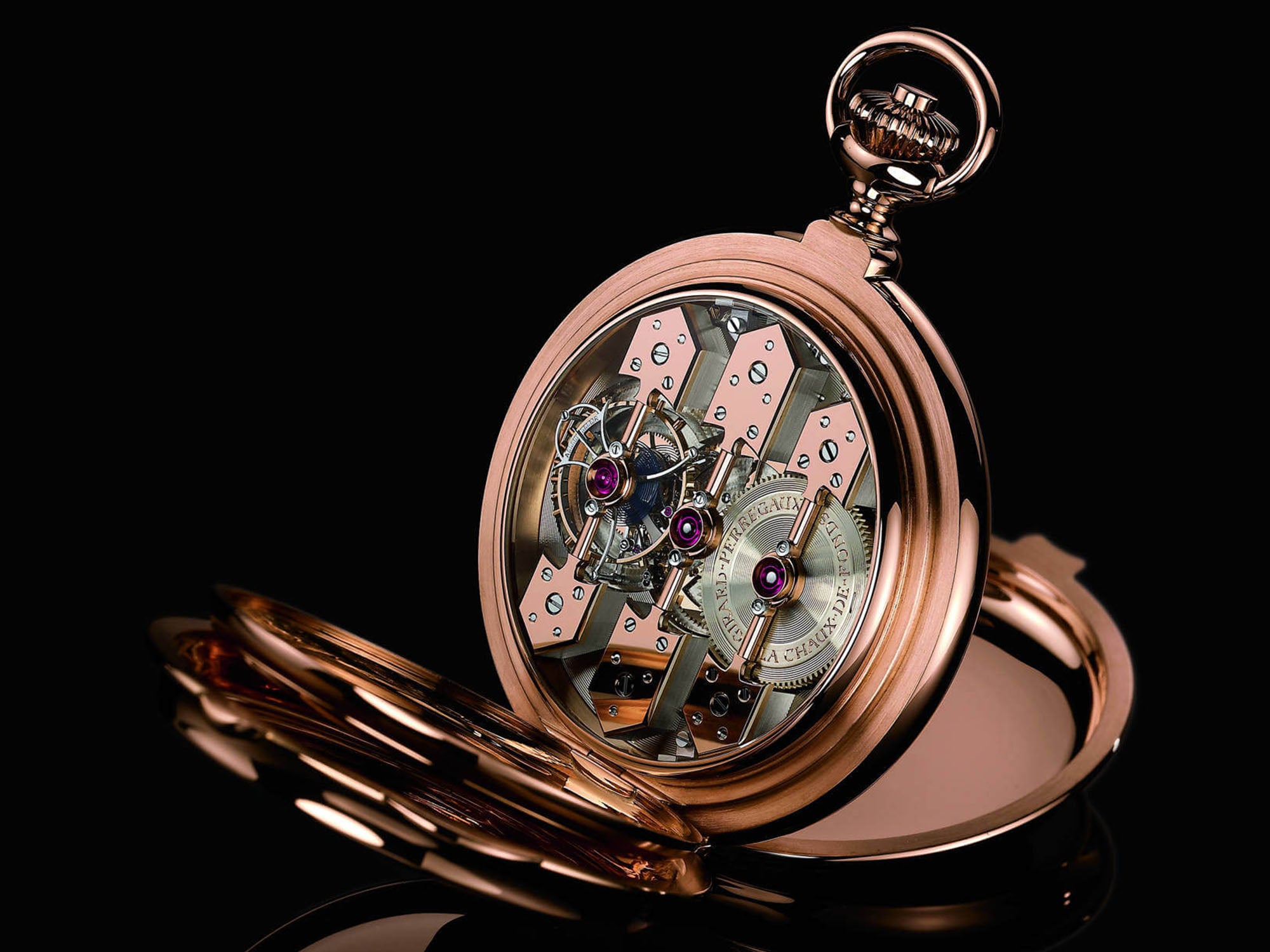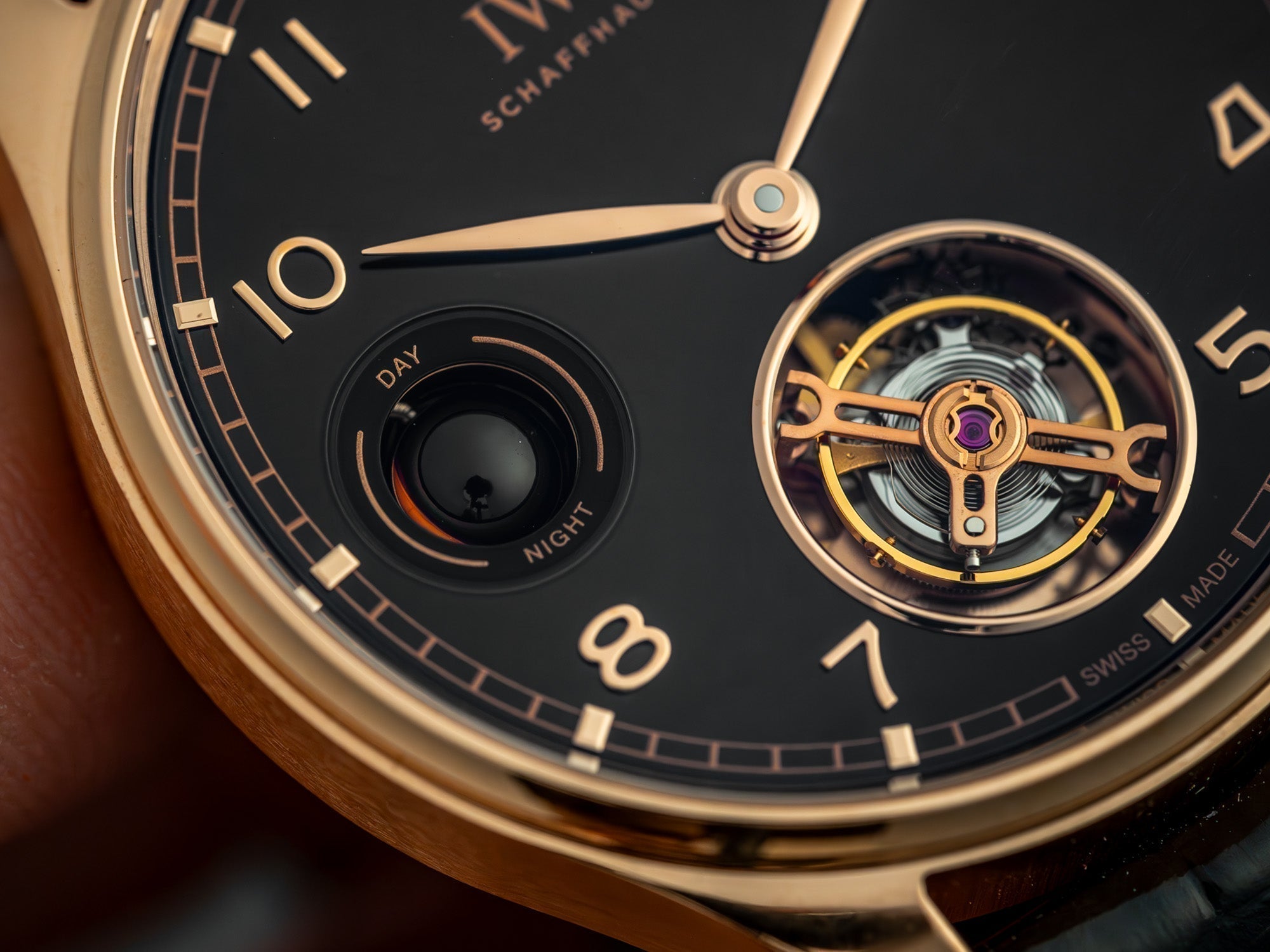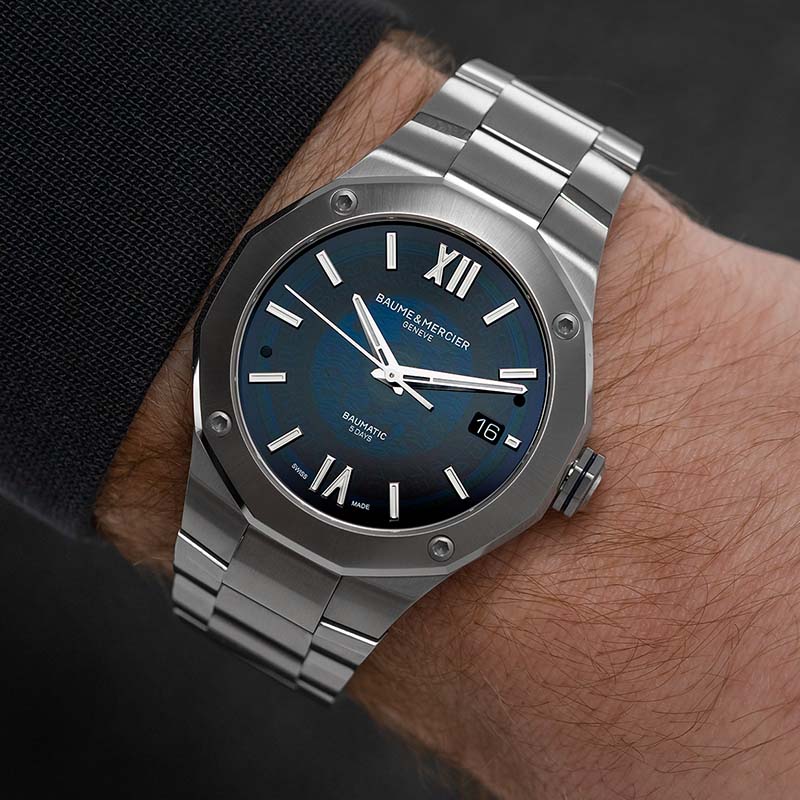For many watch collectors, acquiring one's first tourbillon watch is a Holy Grail, a rite of passage into the upper echelons of horological connoisseurship. If you're new to the watch appreciation game, however, you may be wondering what all the fuss is about. What is so special about tourbillon watches, anyway, and what makes them so desirable to so many while still being so prohibitively expensive for most? The short answer is that a tourbillon is, in this day and age, less of a necessity and more of a badge of historical high-watchmaking excellence. For a more detailed explanation, read on.
The First Tourbillons and Early Innovations
The inventor of the tourbillon is a name that is likely familiar to watch connoisseurs. Abraham-Louis Breguet (1747-1823), a native of Switzerland who plied his trade as a watchmaker in Paris, was one of horology’s most significant historical figures, among whose many innovations was the first self-winding movement, the first repeater movement with a gong, one of the earliest constant-force escapements, and the device that he famously patented in 1801, the so-called tourbillon escapement.

While the tourbillon is today considered by many to be a complication, like a chronograph or calendar mechanism, its original purpose was a fully practical one, to compensate for the ill effects of gravity on the movement of a pocket watch and thus improve its long-term accuracy. Remember, in Breguet’s time, watches were not worn on wrists, where they were often in motion, but carried in waistcoats, where they were upright and stationary for hours on end, leaving their movements — particularly the balance and escapement, the parts devoted to rate regulation and energy transfer — vulnerable to gravitational pull.

Breguet, trained as a physicist and mathematician as well as a watchmaker, devised the ingenious solution of placing these parts inside a mobile cage that rotated 360 degrees on its own axis once per minute, thus reducing their exposure to gravity. He called his invention the tourbillon escapement — tourbillon roughly translating to “whirlwind,” a reference to the cage’s dynamic rotations. Breguet made around 40 tourbillon watches (vintage example above) during his distinguished career; among his clients were European aristocrats and monarchs.

Breguet’s patent on the tourbillon escapement lasted only 10 years, ensuring that his successors could put their own spin (no pun intended) on the groundbreaking device. Constant Girard (one of the founders of today’s Girard-Perregaux) was one of the first to regard the tourbillon as not only a tool to improve accuracy but as something that could add aesthetic value to a timepiece. In 1867, Girard unveiled a pocket watch (above) whose tourbillon was mounted on three golden bridges, a design that exerts influence on Girard-Perregaux tourbillon watches to this day.

A watchmaker and teacher at the German Watchmaking School in Glashutte, Alfred Helwig, worked with a group of students to execute his vision of a “flying” tourbillon in 1920. Helwig’s invention (above) dispensed with the two supporting bridges for the tourbillon cage that Breguet, Girard, and others had employed in favor of a single cantilevered bridge at the bottom side that offered a more unimpeded view into the escapement. The flying tourbillon would prove to be a popular option for ambitious watchmakers in the modern era.
Tourbillons for the Wrist

Pocket watches began giving way to wristwatches around the same time that Helwig and his students developed the flying tourbillon. Perhaps not coincidentally, timepieces equipped with tourbillons began to fade away shortly thereafter; after all, a watch worn on the wrist is not subject to the same gravitational challenges as a watch dangling from a chain, and a device meant to stabilize such a watch’s escapement struck many as prohibitively expensive as well as superfluous. Tourbillon wristwatches were rare throughout most of the 20th Century though they began appearing as early as the 1940s, from heavyweights like Patek Philippe and Omega. It wasn’t until 1986, during the heart of the Quartz Crisis, that the world saw the first series-produced tourbillon wristwatch, Audemars Piguet’s Ref. 25643 (above), which contained the record-breaking Caliber 2870. The watch was not only the first self-winding tourbillon watch; it was also notable for the thinness of its cage (7.2mm) and for its use of titanium, a metal still new to watchmaking.

Two years later, Breguet, the brand founded by the inventor of the tourbillon, launched its tourbillon-equipped Caliber 387 in a gold-cased wristwatch to establish the template for many successors to follow: off-center hours and minutes display at 12 o’clock, tourbillon cage on the dial side at 6 o’clock serving as running seconds display. As the renaissance of the luxury mechanical watch kicked into high gear with the dawning of the 21st Century after years of quartz dominance, the tourbillon would come roaring back in a big way, and Breguet would remain a leader in the horological category that its namesake had established — though far from the only one.

Once a watch with a tourbillon became an object of desire among watch aficionados, watches with more than one tourbillon — as well as watches that combined tourbillons with other complications — became inevitabilities. France’s Robert Greubel and Great Britain’s Stephen Forsey teamed up to establish their eponymous Swiss-based watch brand in 2004, and they kicked it off with a bang: the Greubel Forsey Double Tourbillon 30º (above) was a timepiece unlike anyone had seen before, with not one but two tourbillon cages, rotating at two different speeds on two separate axes, with the inner cage set at an angle to the outer one.

The attention-grabbing timepiece established Greubel Forsey, which would go on to innovate even further, with watches like the Tourbillon 24 Secondes and Quadruple Tourbillon à Differentiel, as an indie brand to be reckoned with. The latter model, as its name implies, packed no less than four tourbillon carriages, linked by a differential device that distributed their energy evenly. Roger Dubuis, another brand founded by a modern watchmaking visionary, has made skeletonized double-tourbillon movements its stock-in-trade since 2005, when it introduced the original Excalibur Skeleton Double Flying Tourbillon (above).

The trend toward slimming down in high-complication watches has been in full swing for a while, and tourbillon watches have not been excepted from the ultra-thin trend. For several years, the title of world’s thinnest tourbillon wristwatch was swapped back and forth between watchmakers like Piaget (with the Emperador Coussin Tourbillon Automatic), Arnold & Son (with the UTTE, or “Ultra Thin Tourbillon Escapement”), and, of course, Breguet (with the Classique Tourbillon Extra-Thin Automatic 5377). Italian jeweler-watchmaker Bulgari attained the bragging rights for the world’s thinnest tourbillon (as it does for the “world’s thinnest” examples of many other watch categories today) in 2018 with the Octo Finissimo Tourbillon Automatic (above), coming in at a super-svelte 3.95mm thick, with a self-winding tourbillon caliber measuring under 2mm.

The ongoing duel for slimness supremacy in the tourbillon world continues, with Piaget masterfully seizing the title again in 2025 with its Altiplano Ultimate Tourbillon (above). The watch somehow manages to incorporate a flying tourbillon caliber into a waiflike 2mm-thick case made from PVD-coated cobalt. The tourbillon itself is made in lightweight titanium and the entire watch is only about as thick as a coin. These are far from the only notable tourbillon timepieces that today’s envelope-pushing watchmakers have produced in the last decade or so. Below we spotlight 10 more that are on the market now and worthy of your attention (as well as, if you can swing it, possibly your money).
Breguet Classique Double Tourbillon 5345 Quai de l’Horloge
 Released in 2020, this elaborately decorated version of Breguet’s Classique Double Tourbillon pays the most direct tribute yet to founder Abraham-Louis Breguet and to the Parisian workshop where he created his early masterpieces. The Swiss manufacture’s 21st-Century technical mastery is lavishly on display in the watch, whose two-tourbillon movement, connected by a differential device and on display behind a sapphire dial, rotates the entire dial plate in sequence with the passing hours. The manually wound Caliber 588N boasts an array of hand-finished components, including mainplates and bridges in solid gold, a Breguet first. On the movement’s front side, the barrel bridges take the shape of the signature Breguet “B.” On its rear side is the painstakingly applied micro-artistry that lends the model its name: a rendering of the “House on the Quai,” the workshop on Paris’s Ile de la Cité where Abraham-Louis Breguet plied his trade back in the 18th Century. The watch’s round, 46-mm case is made of platinum, with the brand’s signature fluting on the sides, and topped with a box-type sapphire crystal.
Released in 2020, this elaborately decorated version of Breguet’s Classique Double Tourbillon pays the most direct tribute yet to founder Abraham-Louis Breguet and to the Parisian workshop where he created his early masterpieces. The Swiss manufacture’s 21st-Century technical mastery is lavishly on display in the watch, whose two-tourbillon movement, connected by a differential device and on display behind a sapphire dial, rotates the entire dial plate in sequence with the passing hours. The manually wound Caliber 588N boasts an array of hand-finished components, including mainplates and bridges in solid gold, a Breguet first. On the movement’s front side, the barrel bridges take the shape of the signature Breguet “B.” On its rear side is the painstakingly applied micro-artistry that lends the model its name: a rendering of the “House on the Quai,” the workshop on Paris’s Ile de la Cité where Abraham-Louis Breguet plied his trade back in the 18th Century. The watch’s round, 46-mm case is made of platinum, with the brand’s signature fluting on the sides, and topped with a box-type sapphire crystal.
Jaeger-LeCoultre Master Ultra-Thin Tourbillon Moon

Jaeger-LeCoultre has been developing sophisticated combinations of horological complications since its founding — and has pioneered some truly complex tourbillon movements in the 21st Century — yet it had somehow not produced a timepiece with both a tourbillon and moon-phase until 2020. The maison remedied that historical oversight with the launch of the Master Ultra-Thin Tourbillon Moon. The watch, which also incorporates the brand’s signature peripheral “jumping date,” has a 41-mm case made of a new alloy called “Le Grand Rose” gold, which offers exceptional sheen and depth of color and is highly resistant to fading over time. The elegantly symmetrical design of the eggshell-white dial unites a Northern Hemisphere moon-phase display, with a polished gold lunar disk, at 12 o’clock; a set of golden Dauphine hands for hours and minutes; and an expansive aperture at 6 o’clock for the tourbillon, distinguished by its polished rose-gold bridge. As a bonus, surrounding the 12 o’clock display are additional indications for the Southern Hemisphere moon-phases on the left and numerical markers for the age of the moon on the right. Jaeger-LeCoultre’s self-winding, automatic Caliber 983, based on the award-winning 978 movement introduced in 2009, powers the timepiece, amassing a power reserve of 45 hours.
Arnold & Son UTTE

Arnold & Son, a prestigious, Swiss haute horlogerie brand named for legendary British watchmaker John Arnold, is no stranger to innovative tourbillon timepieces, and in 2013 the company, now owned by Japan’s Citizen Group, held the title for thinnest tourbillon watch on the market. The Arnold & Son UTTE (the initials are for “Ultra Thin Tourbillon Escapement”), staged an impossibly thin flying tourbillon caliber — just 2.97mm thick — inside a precious metal case whose diameter was a substantial 42mm but whose thickness was a super-slim 8.3mm. The manually wound movement, Caliber A&S200, whose tourbillon cage actually rises slightly above the stated 2.97mm thickness to become a presence on the dial, also stores a 90-hour power reserve in its two barrels. The original UTTE was available in a rose gold or palladium case with a silvered white guilloché dial; subsequent versions included one with a skeletonized version of the tourbillon movement and several with lacquered and Tahitian mother-of-pearl dials.
A. Lange & Söhne Cabaret Tourbillon
 In 2008, German haute horlogerie house A. Lange & Söhne brought a technical upgrade to the tourbillon that was both subtle and substantial. The Saxon brand’s Cabaret Tourbillon featured the first tourbillon movement with a stop-seconds function. Lange’s manufacture Caliber L042.1 is designed to enable the oscillating balance inside the tourbillon cage to be reset to the precise second by pulling the crown, which triggers a complex lever mechanism that pivots a movable V-shaped spring onto the balance wheel rim, stopping the balance instantly. The arresting spring is shaped to ensure the correct amount of pressure on the balance regardless of the cage’s position, and the mechanism preserves the potential energy of the stopped balance spring so that it can restart instantly after the crown is pushed back in. Lange revived the Cabaret Tourbillon in 2021 as a limited edition in its exclusive, artisanal Handwerkskunst collection; that watch (pictured) has a rectangular platinum case and a hand-executed textured lozenge pattern in the center of its white-gold dial.
In 2008, German haute horlogerie house A. Lange & Söhne brought a technical upgrade to the tourbillon that was both subtle and substantial. The Saxon brand’s Cabaret Tourbillon featured the first tourbillon movement with a stop-seconds function. Lange’s manufacture Caliber L042.1 is designed to enable the oscillating balance inside the tourbillon cage to be reset to the precise second by pulling the crown, which triggers a complex lever mechanism that pivots a movable V-shaped spring onto the balance wheel rim, stopping the balance instantly. The arresting spring is shaped to ensure the correct amount of pressure on the balance regardless of the cage’s position, and the mechanism preserves the potential energy of the stopped balance spring so that it can restart instantly after the crown is pushed back in. Lange revived the Cabaret Tourbillon in 2021 as a limited edition in its exclusive, artisanal Handwerkskunst collection; that watch (pictured) has a rectangular platinum case and a hand-executed textured lozenge pattern in the center of its white-gold dial.
Omega De Ville Central Tourbillon Numbered Edition

Omega pays tribute to its mostly under-the-radar history as maker of one of the first wristwatch tourbillons in 1947 with a modern milestone: the first manual-winding, wrist-worn tourbillon that meets the standards of Omega’s in-house Master Chronometer certification. The 43-mm case of the De Ville Tourbillon Numbered Edition has a case middle made from the brand's proprietary Canopus gold, while the bezel, lugs and caseback are in Omega’s in-house Sedna gold alloy. The dial, also made from Sedna gold, has a sun-brushed, black PVD finish and a tourbillon cage occupying its center, with hand-polished bevels made of black ceramized titanium. A large sapphire window in the caseback offers a rear view of the movement, Omega’s Co-Axial Master Chronometer Caliber 2640, whose tourbillon escapement makes one complete revolution per minute and can continue its rotation even under the influence of magnetic fields up to 15,000 gauss — a first for any wristwatch tourbillon.
Vacheron Constantin Patrimony Traditionnelle 14-Day Tourbillon

A watch with a tourbillon is special; a watch with a tourbillon and a two-week power reserve is practically unheard of. But that’s what Vacheron Constantin gave the world in 2013 with the Patrimony Traditionnelle 14-Day Tourbillon, part of the manufacture’s ultra-exclusive Platinum Excellence collection. The clean, sandblasted platinum dial features off-centered hour and minute hands, an aperture for the tourbillon at 6 o’clock, and an analog power reserve indicator at 12 o’clock. The power-reserve display features a “trailing” or “dragging” hand to indicate the remaining energy in the movement’s four mainspring barrels on an arc-shaped scale that is evenly divided into 14 segments — one for each day in the exceptionally lengthy power reserve — each of which is divided in turn into two 12-hour sectors for a more precise reading. The tourbillon carriage is designed to resemble Vacheron Costantin’s Maltese cross emblem, each of its rounded tourbillon bars requiring 11 hours of hand craftsmanship. The 42mm platinum case is mounted on an alligator strap whose contrast stitching is executed with silk and platinum threads.
Grand Seiko Kodo Constant Force Tourbillon

In 2020, Japan’s Grand Seiko introduced the T0 Constant-Force Tourbillon, a concept movement that incorporated a tourbillon and a constant-force mechanism on a single axis, a world’s first horological mechanism. Two years later, Grand Seiko adapted this revolutionary movement into a wristwatch, called Kodo (Japanese for “heartbeat”). Hosting Grand Seiko’s first mechanical complication (and also its first skeletonized caliber), the watch features a 43.8mm case made of 950 platinum and “Brilliant Hard” titanium with alternating hairline-brushed and Zaratsu-polished finishes. The hand-finished movement, Caliber 9ST1, is a smaller version of the 2020 prototype that has also been engineered to be more stable and accurate. The integration of the mechanisms — the inner tourbillon cage rotating to the balance’s 8 beats per second and the outer constant-force device harmonizing with its motions at one impulse per second — deliver both a visually stunning display and the telltale auditory “heartbeat” from which the watch derives its name. In keeping with tradition, Grand Seiko has endeavored to make the Kodo not only a micromechanical triumph but also a beautiful and wearable watch: the hand-finished case is attached to a calfskin strap that has been treated in the traditional method used historically for samurai armor, painted by hand and finished with multiple layers of Urushi lacquer.
H. Moser & Cie. Pioneer Cylindrical Tourbillon Skeleton
In 2020, Schaffhausen-based, iconoclastic indie brand Moser teamed with MB&F to create a watch with a corkscrew-shaped, cylindrical tourbillon inspired by an 18th century chronometer movement. The Pioneer Cylindrical Tourbillon Skeleton, unveiled in 2022, takes that concept and integrates it into a skeletonized caliber for maximum dynamic effect. The one-minute flying tourbillon, prominently placed at 6 o'clock under the domed sapphire crystal, has a hairspring that rises perpendicularly above its balance spindle as it oscillates, an architecture that generates less friction on the pivots and helps maintain better isochronism. Balancing out the tourbillon cage is a subdial at 12 o'clock for the hours and minutes. Domed to echo the curve of the crystal, this small dial is executed in Moser's signature Funky Blue fumé-style coloration, with indexes treated in Globolight, a ceramic-based luminous substance Moser introduced in 2020. Caliber HMC 811, the openworked tourbillon movement that powers this 42.8mm watch, is also a visual treat from the back, with its mainplate and bridges finished in anthracite PVD and its large gold skeleton rotor amassing an impressive 72-hour power reserve.
F.P. Journe Tourbillon Souverain Vertical

French master watchmaker Francois-Paul Journe built his independent brand on the foundation of the Tourbillon Souverain, a prototype he created in 1999. The avant-garde timepiece was the first series-produced wristwatch with both a tourbillon and a remontoir d’egalité, a mechanism designed to transfer constant force from the mainspring to the escapement, effectively eliminating the problem of a watch’s accuracy diminishing as its mainspring runs down. In 2003, Journe, an admirer of Abraham-Louis Breguet, updated the invention with another horologically complex mechanism from the past, a “dead-beat” or jumping seconds display. In 2019, the anniversary year for both the watch and his eponymous brand, Journe unveiled the Tourbillon Souverain Vertical, adding a new vertically inclined positioning for the tourbillon cage, which made its rotation every 30 seconds rather than every minute. Journe’s usual obsession with chronometry is in this model joined with a flair for showmanship: around the dial’s tourbillon aperture is a mirrored ring that draws light and attention to the rotating carriage.
Audemars Piguet Royal Oak Concept Black Panther Flying Tourbillon
 Looking ahead to the big 50th anniversary year for its emblematic Royal Oak collection in 2022, Audemars Piguet launched a partnership with entertainment giant Marvel to produce a series of high-end timepieces, the first of which was a unique piece in white gold. (250 additional pieces were made in titanium.) The large, sculptural case of the Royal Oak Concept Black Panther Flying Tourbillon is made of white gold and sports a hand-engraved motif inspired by the fictional African nation of Wakanda and a hand-painted 3D figure of that nation’s ruler, Marvel’s Black Panther character, aka Price T’Challa, poised on the dial above the flying tourbillon. The unique piece was sold for $5.2 million, not at an auction house but at a 2021 celebrity event hosted by comedian Kevin Hart, with star athletes and vocal AP ambassadors LeBron James and Serena Williams in attendance.
Looking ahead to the big 50th anniversary year for its emblematic Royal Oak collection in 2022, Audemars Piguet launched a partnership with entertainment giant Marvel to produce a series of high-end timepieces, the first of which was a unique piece in white gold. (250 additional pieces were made in titanium.) The large, sculptural case of the Royal Oak Concept Black Panther Flying Tourbillon is made of white gold and sports a hand-engraved motif inspired by the fictional African nation of Wakanda and a hand-painted 3D figure of that nation’s ruler, Marvel’s Black Panther character, aka Price T’Challa, poised on the dial above the flying tourbillon. The unique piece was sold for $5.2 million, not at an auction house but at a 2021 celebrity event hosted by comedian Kevin Hart, with star athletes and vocal AP ambassadors LeBron James and Serena Williams in attendance.
IWC Portugieser Hand-Wound Tourbillon Day & Night

Introduced during IWC’s major overhaul of its elegant, historical Portiugieser collection in 2024, the Portugieser Hand-Wound Tourbillon Day & Night features a case made of the brand’s proprietary Armor Gold and contains the manually wound manufacture Caliber 81925. The lacquered obsidian dial, with a finely polished finish and gold-plated details, has a large aperture at 6 o’clock offering a view of the flying one-minute tourbillon, which consists of 56 individual parts, weighs only 0.675 grams, and makes a complete rotation on its axis every 60 seconds.Joining the tourbillon in its own, smaller aperture at 9 o’clock is an ingenious day-night indicator whose primary element is a small, three-dimensional orb with a dark side and a bright side, representing a planet in daytime and nighttime hours and rotating once every 24 hours on its own axis in synchronization with the passing of daytime to nighttime and back again. Because the movement is manually wound, with no rotor to obscure the back view, this orb is visible from both sides, as the caseback affords a view through a sapphire pane. The 42mm case fastens to the wrist with a Santoni alligator leather strap.
TAG Heuer Carrera Chronograph Tourbillon

TAG Heuer is known more for motorsport-inspired chronographs than tourbillons, but the brand achieved a watch-world milestone in 2016 with the release of its first watch outfitted with both a “flying” tourbillon escapement and a chronograph. Also notably, the Carrera Chronograph Tourbillon boasted both a COSC chronometer certification and an MSRP that was tens of thousands of dollars lower than most tourbillon-equipped timepieces (just $15,950 at release). The latest versions contain the automatic caliber TH20-09, based on the earlier Heuer 02-T, developed in-house — which features automatic winding (still a relative rarity in a tourbillon), a frequency of 4 hz (28,800 vph), an integrated, column-wheel-controlled chronograph, and a power reserve of more than 65 hours in a single barrel. The tourbillon cage at 6 o’clock is exceptionally lightweight, with parts made of titanium and carbon, and serves as a running seconds counter. Bordering the tourbillon cage at 3 and 9 o’clock are the subdials for elapsed chronograph minutes and hours. TAG Heuer introduced a 250-piece limited edition in a blue colorway and a titanium case and bracelet in 2021, and followed it up in 2024 with a model in brushed steel with a striking teal sunburst dial.
Breitling Top Time Classic Cars Tourbillon

Breitling’s Top Time series has roots in the 1960s and pays homage to that era’s muscle cars and motorcycles. In 2023 came the first models outfitted with Breitling’s proprietary Caliber B21, which offers the rare horological combo of a chronograph and a tourbillon. Created in partnership with La Joux-Perret, this COSC-certified engine with a 55-hour power reserve beats inside cases made of materials that are both exotic and rarely found in Breitling’s current portfolio. For the Top Time B21 Chevrolet Corvette and B21 Shelby Cobra, the case material is black ceramic, with titanium for the caseback, crown, and chronograph pushers, as well as for the buckle on the leather strap. The dial of the Shelby Cobra is dark blue, like the livery of the original car, while the dial of the Corvette edition is fashioned from walnut burl, evoking the wooden dashboards of its namesake roadster. The B21 Ford Mustang edition has a case made of. bronze, with a titanium caseback, crown, and pushers, and a green dial that echoes the paint job of the first-generation Mustang produced until 1974. Instead of the classic’ two- or three-register design of the Top Time chronograph models, the dials of the Tourbillon editions hosts a balanced arrangement of an aperture for the tourbillon cage at 12 o’clock, directly above a “squircle” subdial at 6 o’clock to tally the chronograph’s elapsed minutes.
Hublot Big Bang Integrated Tourbillon Automatic Full Texalium Carbon

Hublot, which has built its identity on its pioneering use of unconventional materials in watchmaking, has made a number of attention-grabbing tourbillon watches. The name of this one is a mouthful, but that’s because it’s got so much going on, both from a materials and mechanics perspective. The familiar case of this 50-piece limited edition is made from an inner core of carbon fiber and overlaid with a layer of Texalium, a proprietary amalgamation of fiberglass and aluminum, for additional robustness; the fusion of the materials, which are also used for the signature integrated bracelet, makes for a watch that is exceptionally lightweight despite its size, durability, and technical complexity. The inner heart of the watch, on display through the open dial thanks to its meticulous skeletonization, is Hublot Caliber HUB6035, the brand’s first self-winding tourbillon caliber, which achieves its three days (72 hours) of running autonomy via a 22k gold micro-rotor, placed unconventionally at 12 o’clock on the dial side and thus in full view on the wrist. The movement’s symmetrical architecture positions this microrotor, with its openworked “Hublot” logo, directly above the one-minute rotating tourbillon cage at 6 o’clock.
Frederique Constant Classic Tourbillon Manufacture

When Frederique Constant unveiled its first tourbillon watch, all the way back in 2008, it was a major coup for the brand, but also a somewhat appropriate evolution of its collection, as it took the open “Heart Beat” dial design of some of its early models to the next level. In 2023, on the occasion of its 35th anniversary, Frederique Constant revamped its exclusive tourbillon movement, Caliber FC-980, and released it in a series of limited editions over the next couple of years. This 150-piece limited edition is the first to combine a polished, stainless steel case with FC’s “palm green” dial. The 39mm case is water-resistant to 50 meters, with a large, fluted, pocketwatch-inspired onion crown that has become emblematic of the model. The dial’s seconds hand has been incorporated into the upper bridge of the tourbillon, whose 81-part rotating cage is in full, spectacular view in the large aperture at 6 o’clock. The tourbillon’s anchor and escapement are made from silicon, an antimagnetic and temperature-resistant material that Frederique Constant was one of the first Swiss watchmakers to use. The dial-matched green strap is made from alligator leather with tone-on-tone topstitching.
Blancpain Fifty Fathoms Tourbillon 8 Jours

Blancpain, one of the oldest watchmakers in the world, had been known chiefly for elegant, complicated timepieces rather than tool watches when it revolutionized watchmaking and forever changed its own perception within the watch enthusiast community with the introduction of the Fifty Fathoms in 1953. The Fifty Fathoms is regarded as the first “modern” diver’s watch, introducing such staples as the one-way rotating bezel, and has grown to become a key pillar in the venerable Swiss maison’s collection. The pinnacle of high horology within the Fifty Fathoms family, the Tourbillon 8 Jours, takes the iconic watch far from its utilitarian origins to embody Blancpain’s historical savoir faire in mechanical complications. Its self-winding movement is equipped with a one-minute flying tourbillon, visible through an aperture in the dial (made of blue ceramic in the model shown here) and amasses an astonishing eight-day (“8 jours” en francais) power reserve. The watch comes in rose gold, white gold, and titanium cases; earlier versions have a power reserve indicator on the dial at 6 o’clock; the more recent versions released in 2021 eschew this display for a cleaner look.
Glashütte Original Senator Chronometer Tourbillon

Glashütte Original’s Senator collection combines classically timeless Saxon design with a high level of technical sophistication befitting a 21st Century luxury brand. The elegant gents’ collection is impressively diverse in its offerings, including high-complication icons like the Cosmopolite World Timer and the Chronometer Tourbillon, the latest update of which occurred in 2023. The watch, a boutique-exclusive limited edition of 25 pieces, builds upon Alfred Helwig’s legacy by incorporating a flying tourbillon with a stop-seconds mechanism that allows for precise synchronization of the minutes and seconds hand; pulling out the crown immediately stops the tourbillon’s rotating cage, on which the seconds hand is mounted, enabling easy resetting of the latter indication. The ingenious, manually wound Caliber 58-08, for which Glashütte Original has applied for several patents, has been tested for chronometric precision by an independent agency and beats at 21,600 vph inside a 42mm platinum case, achieving a 70-hour power reserve. The dial’s openworked architecture ensures a breathtaking view on the wrist along with the rare level (for a tourbillon wristwatch) of elite timekeeping precision that would likely have made both Helwig and Breguet proud.


























































0 Comments